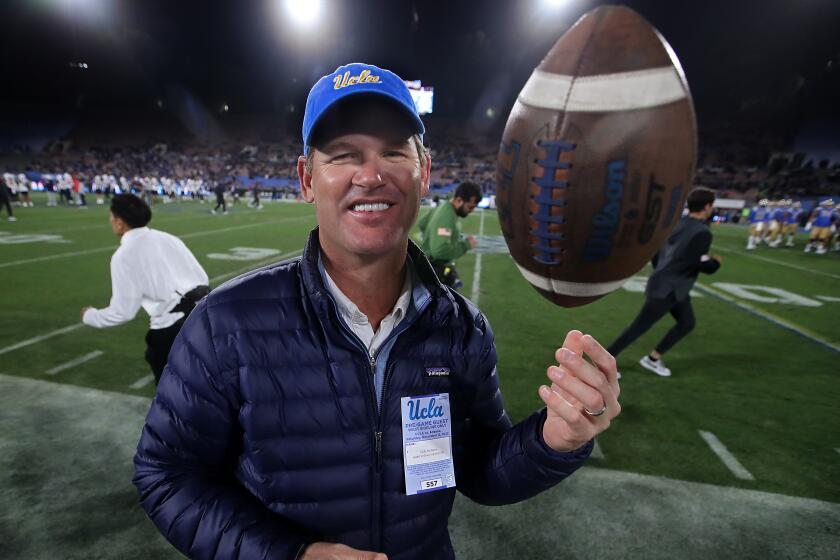TENNIS / GENE WOJCIECHOWSKI : Wimbledon Was Prepared for ‘Problem Fans,’ Including Pierce
Security has become a major priority at Wimbledon. Tennis stalkers . . . obsessive fathers . . . the possibility of terrorism--they all have contributed to the increased presence of police officers and contingency plans.
So skittish are officials about the arrival of so-called “problem fans” that photographs of the best-known offenders have been posted within the Wimbledon complex.
Included on the list is Jim Pierce, father of Mary Pierce. Pierce, known for his abusive behavior toward his daughter, is banned from attending WTA Tour events.
For reasons still not entirely clear, Mary Pierce, seeded seventh at Wimbledon, withdrew before the tournament. Billie Jean King, a former Wimbledon champion and HBO broadcaster, suggested that Pierce’s departure had more to do with her fear of playing on grass than the possibility of Jim Pierce making an uninvited appearance.
Maybe so, but posters of Jim Pierce were distributed to Wimbledon security guards that read: “This man is banned from the grounds. Stop him from entering if possible. However, if sighted he must not be challenged but control must be informed.”
As for King’s theory that Mary Pierce ducked Wimbledon, not everyone agreed with the assessment. Former Wimbledon champion Boris Becker recently had dinner with Pierce. The two discussed the situation, specifically Jim Pierce.
“I strongly think that she had a bit of a problem with her father, and you know, she is a very good tennis player obviously,” Becker said. “She doesn’t have to fear nobody.”
Pierce defeated Steffi Graf at the French Open and has been hailed as the newest star on a tour in need of fresh faces.
“It’s quite a new life for her, and you know, with having a father like that, what could she do really?” Becker said. “You know, everything has been so fast now. In about four weeks, you know, she is supposed to save the women’s game and I think she needs time to think about the whole picture, what she wants to do in tennis and then she is going to be back strong.”
*
In a mostly uneventful first-round 6-4, 6-3 loss to Larisa Neiland, American Katrina Adams was summoned to a postmatch news conference by curious British tabloid reporters.
After an obligatory question about Adams’ play, the reporters zeroed in on the controversy that mattered.
Question: “Your colorful clothing caused a little bit of a stir, I understand, on Court Five--particularly your underwear. Can you tell us about that?”
That’s right, an underwear expose.
Adams’ multicolored tennis undies, called Fancy Pants, were seen early and often because of the blustery conditions. If they were noticeable, it was only because of the All England Lawn Tennis Club’s strict rule regarding predominantly white playing wear.
Adams’ tennis pants were pink, green, black and white.
“If it’s any consolation to you,” the British reporter said, “we all thought they were very attractive anyway.”
Said Adams, who was making her seventh appearance at Wimbledon: “Thanks a lot. You saw my bottom a lot today, huh? No peeping Toms or anything.”
Meanwhile, the fashion police found time to criticize the ultra-baggy (by tennis standards) shorts worn by Americans Andre Agassi and Pete Sampras.
Agassi has said the shorts were designed at his request, though a Nike spokesman reportedly disputed the claim. Nike said Sampras first wanted a looser-fitting pair of shorts.
Whatever the case, the baggies weren’t much of a hit with the upper crust at Wimbledon.
“Agassi looked an absolute mess,” Alan Little, librarian at the Wimbledon museum, told the London Times.
“I have never seen anyone look so scruffy on a Wimbledon court. I hope this doesn’t start yet another fashion.”
Little has seen every male Wimbledon champion since 1950. He remains no fan of Agassi’s court-wear tastes.
“At this rate he could be in long johns next year,” he said.
*
In an effort to make ATP Tour matches more interesting, the respective Player and Tournament Councils recently announced four changes in policy:
--Spectators, who usually are expected to keep their mouths shut, will be allowed “to spontaneously react during a point as long as it is not intended to distract players.”
--The time between points will be reduced from 25 seconds to 20.
--Fans with seats in the upper reaches of tennis stadiums will be allowed to move in and out during points.
--Microphones will be positioned so conversations between players and officials can be heard by the audience.
Some of the changes go into effect as early as July 18, but according to Bud Collins, a Tennis Hall of Fame inductee who writes for the Boston Globe and does analysis for NBC, the ATP Tour could have--and should have--done more.
Collins wanted the ATP Tour to open the men’s locker room to reporters. With the exception of the U.S. Open, no other tournament allows locker room access to journalists--a given in almost all other major sports.
The better the access, Collins said, the better chance the average tennis fan would learn more about the players on the tour.
That might translate into more interest.
Collins also suggested the ATP Tour put a clock on the court ( a la the NBA’s 24-second shot) for the latest time rule change.
*
The trickle-down effect from Jennifer Capriati’s arrest could soon be seen on the WTA Tour.
Members of a Women’s Tennis Council select panel have completed their research on age minimums for players and new rules could be instituted by next year. The panel’s results will be released during the U.S. Open, which begins Aug. 29.
At present, players 14 and older are allowed to compete on the tour. But there is a movement to increase the limit to 16, maybe even as high as 17--partly because of reaction from Capriati’s April arrest on marijuana possession.
Critics of the current minimum-age standard contend that Capriati’s situation could have been the partial result of her early entrance on the WTA Tour.
Others, such as Billie Jean King, who contributed to the select panel’s research, are less sure about the effects of increasing the limit.
“There have been many 13- and 14-year-olds, like Steffi Graf and Gabriela Sabatini, who have made the adjustment to pro life, but the media deals with just the exceptions,” King said.
More to Read
Get our high school sports newsletter
Prep Rally is devoted to the SoCal high school sports experience, bringing you scores, stories and a behind-the-scenes look at what makes prep sports so popular.
You may occasionally receive promotional content from the Los Angeles Times.






